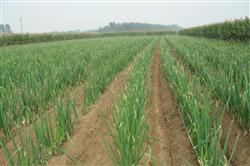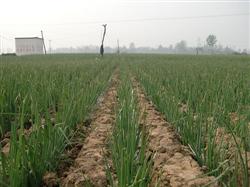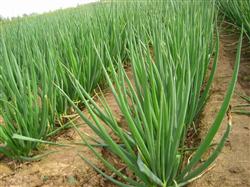How to grow out-of-season green onions?

How do you plant seasonal onions? Please give an introduction to the anti-season onion can refer to the following methods for planting: 1. Variety selection: When planting scallion listed in the off-season, we should select cold-resistant, bolting-resistant, heat-resistant, disease-resistant and high-quality scallion varieties. Such as Zhangqiu Changbai green onion, Chinese giant onion excellent line and other varieties. 1. Seedling and planting time arrangement: the first crop, seedling from the end of June to the beginning of July, planting in September, listing in March to April of the second year; the second crop, seedling in mid-September, planting in March to April of the second year, listing in August to early September. 2. Seedling selection: Since the seedling time of the two crops is almost in the rainy season, it should be selected that the land is flat, the terrain is slightly higher, the drought can be irrigated, and the waterlogging can be discharged for more than 3 years without planting scallion, onion, leek, garlic and other lily vegetables. 3. Application of sufficient base fertilizer: due to the short roots of scallion seedlings into the soil shallow, poor ability to absorb soil nutrients, in order to cultivate strong seedlings, must apply sufficient decomposed organic fertilizer and a certain amount of phosphorus, potassium fertilizer. The concrete method is that before ploughing, 5000~6000 kg of decomposed and finely divided manure (except chicken, duck, sheep dung and raw human excrement) shall be applied per mu, and the ridge shall be arranged. Before sowing, 25 kg sulfuric acid type three-element compound fertilizer was applied. 4. Fine harrowing, ridging: in order to prevent underground pests harm seedlings, organic fertilizer spread, should be spread again after a poison bait. That is, 5kg wheat per mu is fried, then mixed with 250ml phoxim diluent, sealed and covered for 3 hours, then spread on the ground, and turned into soil with organic fertilizer, which can kill many underground pests at one time. The ploughed land should be thoroughly raked, compacted and leveled. Before making a furrow, first open a furrow for watering on one side of the ground, and then make a furrow. The clear width of the ridge is 1~1.2 meters, the width of the ridge is 20~23 cm, and the height is 8~10 cm (stepping). After the border is done, first spread 25 kg of three-element compound fertilizer (N, P, K each containing 15%) per mu in the border, hoe thoroughly and flatten, and then sow. 5. Sowing with 3~4 kg per mu two sowing methods, you can choose one. Rake seeds: evenly spread seeds on the flat surface of the bed, carefully rake them with rakes after sowing, so that the seeds are fully mixed with the soil, and buried in the soil shallowly, and then watered. Cover seed: After the ridge is leveled, clear out the fine wet soil of 1 cm thick ridge surface with a flat shovel, and level the ridge surface again. Watering: Stop watering when the water in the border reaches 6~7 cm deep. After the surface of the ridge is dry, it is sown and covered with fine soil with a thickness of about 1 cm. The seedlings planted under cover have deep roots, many roots, many seedlings and strong drought resistance. If you can take the method of shading against storms seedling, the effect is better. Herbicides can be sprayed manually after sowing. 6. The seedling stage is managed from full seedling stage to 5 leaf stage, and the seedlings are thinned for 1~2 times. Spacing 1 - 1.5 cm. In combination with thinning, weed removal is carried out where the herbicide has not killed the weed. Control watering, no drought, no watering, to reduce the incidence of "disease" and "yellowing seedlings". If the seedlings grow thin and weak, they can be combined with watering and appropriate topdressing. 7.5~ 10kg urea per mu is applied with water, once every 20 days, and twice in total. If continuous rainy weather is encountered during growth, attention should be paid to the prevention and control of downy mildew and white blight to ensure strong seedlings. 3. Summer sowing scallion is planted in the middle of September, autumn sowing scallion is planted in March and April of the following year. Row spacing 80 cm, plant spacing 1.5~2 cm, trenching planting (row onion). Before planting, onion seedlings should be strictly graded, and then treated with chemicals to eliminate root maggots (seed fly larvae) and ensure complete seedlings. The specific method is to immerse the roots of onion seedlings in 1.8% alfodine solution diluted 4000 times, phoxim solution diluted 800~1000 times, or beta-cypermethrin solution diluted 3000 times for 2~3 minutes. Planting ditch can not be too deep or too shallow, too deep, dead soil layer unfavorable root growth; too shallow after the cultivation is more difficult. After the planting ditch is opened, the newly turned empty soil should be slightly suppressed to prevent the collapse from overwhelming the onion seedlings in the future. After the onion seedlings are arranged in the ditch, proper amount of root fertilizer should be applied. Root manure is better than decomposed manure. 5000 kg per mu plus 25 kg of three-element compound fertilizer mixed evenly after application. Combined with the opening of the lower channel, a layer of fine wet soil should be properly covered on top of the root fertilizer. Thickness to root fertilizer plus soil do not bury onion heart (growth point) for degrees, a little suppression is over. Just planted onion seedlings are strictly prohibited from watering, in case of retting roots caused by a large number of dead seedlings. In case of rainstorm, we should do everything possible to drain the accumulated water in the onion field. After the seedling is slowed down, we can water it properly in case of drought. IV. Field management After the anti-season Chinese onion planting, the temperature is the most suitable period for the growth of Chinese onion, and the seedlings will grow rapidly as soon as they slow down. Therefore, fertilizer and water management is an important link for high yield and high quality. Those who apply sufficient root fertilizer according to the requirements will not lack fertilizer before the middle stage of growth. As long as the soil moisture is appropriate, they can ensure rapid and healthy growth. The soil temperature should be kept at about 70% of saturated water capacity. Water in case of drought, and tilling and loosening in due time after irrigation, so as to preserve moisture and increase soil permeability, promote root development and improve the ability to absorb water and fertilizer. The length of scallion white is determined by the amount of cultivated soil. Generally, anti-season scallion needs to be cultivated 3~4 times to ensure that the length of scallion white reaches 70~80 cm. The thickness of each time to cultivate soil to not bury the onion heart as a standard. Overwintering cultivation of anti-season scallion, in the ground before freezing a thick soil, try to reduce the amount of leaf drying, accumulation of nutrients, to ensure early development after winter. With the acceleration of growth speed and the increase of leaf mass, the demand for soil nutrients by plants increased sharply. To ensure high yield, topdressing must be done in time. Topdressing can be combined with watering. 15 - 20 kg urea per mu is applied every time. Sow fertilizer along the ditch, and then shallow hoe and bury fertilizer to prevent fertilizer from concentrating into the lower water head with water during watering, so as to achieve the purpose of balanced fertilization. It is better to increase the application of phosphorus and potassium fertilizer, which has significant effect on increasing the yield and improving the quality of Chinese onion. Click to get more green onion planting technology Click to get more vegetable planting technology
- Prev

How to fertilize green onions?
How to fertilize green onions? Please give an introduction to the following methods for planting green onions: when the growth of the plant is accelerated, the "leaf-breaking fertilizer" should be applied once, 15002000 kg of rotten farm manure and 20kg of superphosphate per mu. If the soil fertility is high and the bottom fertilizer is sufficient, this time.
- Next

What are the requirements for green onions to apply fertilizer?
What are the requirements for green onions to apply fertilizer? Please introduce green onions to fertilizer, but the requirement for fertilizer is not high. The root absorption capacity of Welsh onion is weak. In order to increase the yield of Welsh onion, attention must be paid to the application of fertilizer. It is determined that for every 1000 kg of fresh onions, it is necessary to absorb nitrogen (N) 2.7kg, phosphorus (P2O5) 0.5kg, potassium (K2) from the soil.
Related
- Where is it suitable to grow horseradish in China? it is expected to see the middle altitude horseradish in Alishan.
- How to prevent tomato virus disease reasonably? (Control methods included)
- Many people like to plant towel gourd on the balcony. What are the main points of this method and management?
- What crops can chili peppers be mixed with?
- Fertilization techniques and matters needing attention in Tomato
- What are the grafting techniques for peach seedlings in spring?
- Harm and control methods of root swelling disease of Chinese cabbage
- What are the pests of sweet potatoes? How to prevent and cure it?
- Symptoms, causes and Control methods of navel Rot in Tomato
- The cause of "Cucumber rotten bibcock" in Farmers' planting Cucumber and its Control Plan

